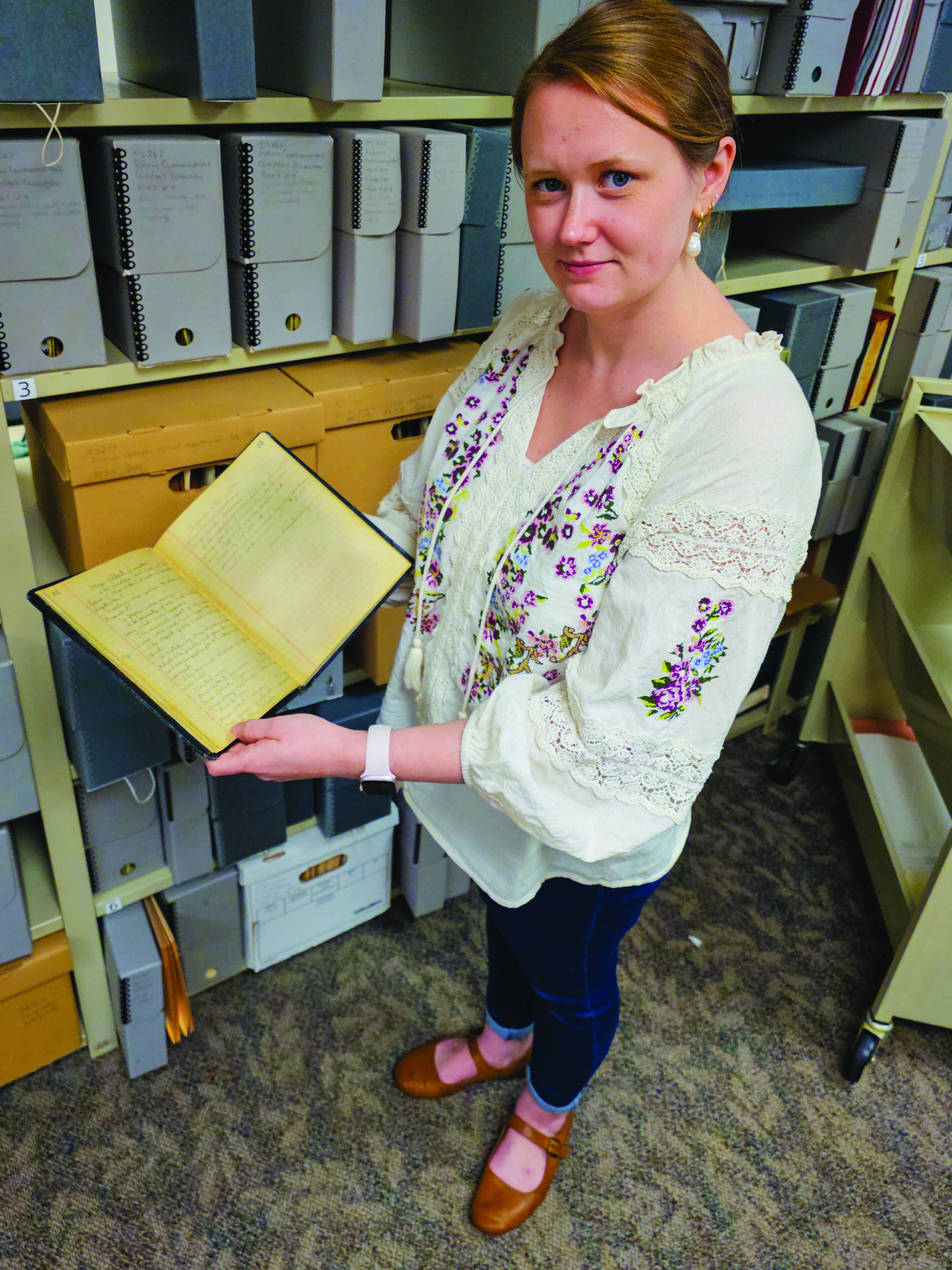
Petra Gunderson-Leith, who was named HCSCC archivist in March, looks over one of Orabell Thortvedt’s daybooks. Her scrapbooks and other documentation of early Moorhead are now being digitized. (Photo/Nancy Hanson.)
“I’ve always known I wanted to work in an area of history. Research, perhaps? Exhibits? Textiles? I’ve been able to do a little of everything since I’ve been here at HCSCC.
This is perfect.” – Petra Gunderson-Leith
Nancy Edmonds Hanson
For only the second time in its history, the Historical and Cultural Society of Clay County has welcomed a new keeper of its voluminous collection of photographs and documents.
Petra Gunderson-Leith has, since March, occupied the office long held by historian Mark Peihl. He retired in February after nearly 40 years as the county’s leading expert on its past.
The 29-year-old Moorhead native says her new role could have been her dream job, had she only known about it when she was growing up. “I’ve always known I wanted to work in an area of history,” she reflects. “Research, perhaps? Exhibits? Textiles? I’ve been able to do a little of everything since I’ve been here at HCSCC. This is perfect.”
Perhaps Petra was born for this job. “I grew up in a family of storytellers,” she reports. “My dad is a journalist – a storyteller.” (He is Dan Gunderson, Minnesota Public Radio bureau chief with KCCM FM.) “My grandpas were storytellers, too, and so was my mom. They were always encouraging me to be interested in people and their stories.”
She began work on her family’s history while in middle school. Through ancestry.com, she connected with a cousin in her 50s. “We began exchanging hints and bits of information,” she remembers. More clues came her way when she inherited her family’s collection of memorabilia – decades-old letters, photographs and other bits and clues to the story she was piecing together.
After graduating from Moorhead High School, Petra enrolled at Minnesota State University Moorhead. There she majored in cultural anthology, the study of how people shape the physical and social world around them. She minored, naturally, in history, along with a second minor in Norwegian at Concordia.
She had her first encounter with local history in 2013, when she completed a year-long work-study stint at HCSCC that included time with her predecessor Peihl. “We were working on cataloging the backlog of archival collections,” she remembers. One assignment: Finding names for photos from the Hawley Herald. “We scanned them and brought copies to the senior center for help identifying them,” she remembers.
After graduation in 2016, Petra worked in the West Fargo Public Library’s history center. She returned to school in 2019, entering North Dakota State University’s master’s program in public history. That brought her back to the Clay County group as a graduate assistant, working with collections manager Lisa Vedaa on its inventory and 3-D collections. After graduating, she went on to work with membership and donations as an administrative assistant. She took time off for the birth of her and husband Ian’s daughter Beatrix before returning to assume her new role.
Six months into her new assignment, the young historian says she is growing more comfortable in her main mission, assisting researchers in finding answers buried deep in Clay County’s past. “At first it was nerve-wracking, given the huge amount of material in our collections,” she admits “I had worked with them before, but now I’ve been able to explore them in more depth, and I’m more comfortable finding what they need.
“Mark made these archives into the amazing resource they are today. Helping researchers is such a joy. They may be looking for information that seems like a tidbit to others – a bit of family lore or the history of a house. To them, it’s really important. It’s so rewarding to be able to help.”
Petra’s deep dive into Clay County is about the future as much as it is the past. “It’s an evolving field. Digital archiving is a scary part of the job,” she observes. “People aren’t sending letters and saving documents in printed form, as they always did in the past. Photographs are digital, rather than prints. Maintaining digital files in the middle of rapidly evolving technology is a continuing challenge.” She has studied best practices with the Society of American Archivists and consumers “every article that pops up,” she says, “but firsthand experience is still the best teacher.”
Right now, she’s engaged in digitizing the voluminous collection of the late Clay County pioneer Orabell Thortvedt – dozens and dozens of scrapbooks, daybooks. She is also doing research for the museum’s upcoming exhibit on food and culture in Clay County.
Petra’s growing list of upcoming future projects, she says, already goes on and on. “I feel like I’m just getting to know our local history,” she reflects. “I’m always surprised at how wild that it can be.
“I’m never, ever bored. As our director Maureen Kelly Jonason says, ‘Jobs in a museum or archives are many lifetimes of work,’” she says. “No one person can possibly accomplish everything that should be done. But I can try.”


